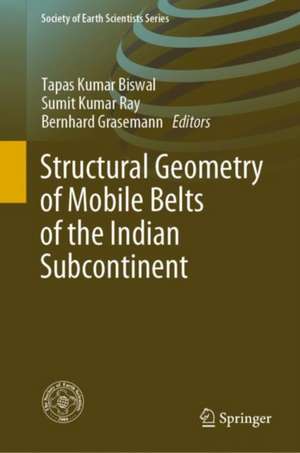Structural Geometry of Mobile Belts of the Indian Subcontinent: Society of Earth Scientists Series
Editat de Tapas Kumar Biswal, Sumit Kumar Ray, Bernhard Grasemannen Limba Engleză Hardback – 22 feb 2020
| Toate formatele și edițiile | Preț | Express |
|---|---|---|
| Paperback (1) | 943.25 lei 6-8 săpt. | |
| Springer International Publishing – 22 feb 2021 | 943.25 lei 6-8 săpt. | |
| Hardback (1) | 949.23 lei 6-8 săpt. | |
| Springer International Publishing – 22 feb 2020 | 949.23 lei 6-8 săpt. |
Din seria Society of Earth Scientists Series
- 15%
 Preț: 696.64 lei
Preț: 696.64 lei - 15%
 Preț: 647.73 lei
Preț: 647.73 lei - 15%
 Preț: 644.49 lei
Preț: 644.49 lei - 15%
 Preț: 641.71 lei
Preț: 641.71 lei - 18%
 Preț: 946.87 lei
Preț: 946.87 lei - 18%
 Preț: 975.92 lei
Preț: 975.92 lei - 18%
 Preț: 725.92 lei
Preț: 725.92 lei - 18%
 Preț: 898.26 lei
Preț: 898.26 lei - 18%
 Preț: 973.25 lei
Preț: 973.25 lei - 18%
 Preț: 890.37 lei
Preț: 890.37 lei - 18%
 Preț: 947.85 lei
Preț: 947.85 lei - 18%
 Preț: 943.25 lei
Preț: 943.25 lei - 18%
 Preț: 726.85 lei
Preț: 726.85 lei - 18%
 Preț: 786.18 lei
Preț: 786.18 lei - 18%
 Preț: 958.88 lei
Preț: 958.88 lei - 15%
 Preț: 642.51 lei
Preț: 642.51 lei - 18%
 Preț: 965.97 lei
Preț: 965.97 lei - 18%
 Preț: 951.14 lei
Preț: 951.14 lei - 18%
 Preț: 952.72 lei
Preț: 952.72 lei
Preț: 949.23 lei
Preț vechi: 1157.60 lei
-18% Nou
Puncte Express: 1424
Preț estimativ în valută:
181.72€ • 189.61$ • 152.33£
181.72€ • 189.61$ • 152.33£
Carte tipărită la comandă
Livrare economică 13-27 martie
Preluare comenzi: 021 569.72.76
Specificații
ISBN-13: 9783030405922
ISBN-10: 3030405923
Ilustrații: XII, 254 p. 97 illus., 77 illus. in color.
Dimensiuni: 155 x 235 mm
Greutate: 0.55 kg
Ediția:1st ed. 2020
Editura: Springer International Publishing
Colecția Springer
Seria Society of Earth Scientists Series
Locul publicării:Cham, Switzerland
ISBN-10: 3030405923
Ilustrații: XII, 254 p. 97 illus., 77 illus. in color.
Dimensiuni: 155 x 235 mm
Greutate: 0.55 kg
Ediția:1st ed. 2020
Editura: Springer International Publishing
Colecția Springer
Seria Society of Earth Scientists Series
Locul publicării:Cham, Switzerland
Cuprins
Timing of South Delhi orogeny: Interpretation from structural fabric and granite geochronology (Beawar-Rupnagar-Babra area, Rajasthan, NW India).- Deformation in the Aravalli Supergroup, Aravalli-Delhi mobile belt, NW India and tectonic significance..- Evolution of the “Central Indian Tectonic Zone”: a critique based on the study of the Sausar belt.- Tectonic Development of the Bengal Basin in Relation to Fold-Thrust Belt to the East and to the North.- Structural imprints of Andaman accretionary prism and its tectonic relation with ophiolite belt of Indo-Burma ranges.- Two and Three-Dimensional Structural Modelling of Central Kohat Plateau, Northwestern Himalaya, Pakistan.- The northern margin of the Eastern Ghats Belt : evidence for strike-slip tectonics along a craton-mobile belt boundary.- A preliminary study on Earthquake source properties based on Geochemistry, Shear resistance and Melt pressure of Pseudotachylites, Gangavalli fault, South India.- Anisotropy of Magnetic Susceptibility (AMS) studies on quartzites of Champaner Group, upper Aravallis: An implication to decode regional tectonics of Southern Aravalli Mountain Belt (SAMB), Gujarat, Western India.- Tectonic implications of small-scale structures in the main central thrust zone of Garhwal Higher Himalaya.- Thrust sheets, tectonic windows, and intermontane basins in the Nepal Himalaya.
Textul de pe ultima copertă
This book summarizes the latest research on the structural geology of the mobile belts of the Indian subcontinent including the Himalayas, NE Himalayas, Bangladesh thrust belt, Andaman subduction zone, the Aravalli‐Delhi, the Central India Tectonic Zone, the Singhbhum, the Eastern Ghats and the Southern granulite terrane. It offers essential information on deformational structures in the mobile belt, such as folding patterns, the character of the shear zone, shear strain analysis, and faults, as well as fault zone rocks. The findings presented here are based on field observations, mapping, sampling and analysis work (e.g. petrographic studies), as well as limited geochemical and geochronological analysis to support the findings. A discussion on the structural evolution of these mobile belts and their connections with other belts rounds out the coverage.
Caracteristici
Presents the latest findings on the mobile belts of the Indian subcontinent Includes an extensive literature review Features a wealth of images from macro- to micro-scale
